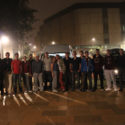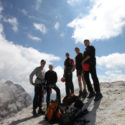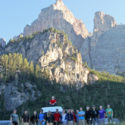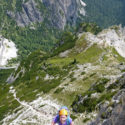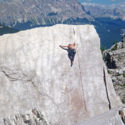On 8th August 2012 12 members of Thunderer Squadron, 3 members of Typhoon Squadron and 1 external Southampton University air squadron instructor met bright and early at 4am ready to depart for a two week rock climbing and via Ferrata expedition. The expedition aims were to enhance leadership, teamwork, provide an introduction to rock climbing and to allow instructors to further rock climbing experience in a mountainous region outside of the UK.
The expedition convoy left Southampton for the Dover – Calais ferry and the onward journey to Fontainebleau. Fontainebleau, South East Paris, offers 100sq km of bouldering. Bouldering is low level climbing often under 5m without harnesses and ropes and instead using large crash mats. This provided a great opportunity for the instructors to assess the level of climbing ability within the group and for expedition members to reacquaint themselves with climbing shoes.
After a day spent in Fontainebleau the convoy rolled on 13hrs to Sass Dlacia near Cortina in the Dolomites. Arriving at 11pm the group had no sense of the spectacular scenery waiting until the following morning.
The first day in Italy saw the group head to Sass de Stria, a local crag on the Falzarego pass. The aims of the day were to ensure all members were competent with basic rope work and climbing techniques that would be required over the following 9 days. Several more experienced members completed their first lead climb, definitely a moment to remember with a spectacular back drop.
Once settled in the Dolomites the groups rotated between single pitch sport climbing, mutlipitch mountain routes and Via Ferrata during the normal working hours. After this, personal climbing was completed by those who still had the energy.
The Via Ferrata routes provided an insight to a less well known part of WW1 history. Many of the routes were originally setup to aid the movement of mountain troops in across difficult terrain and include the wartime tunnels and trenches, exposed ridges and narrow ledge traverses providing both an adventure and education in a single day. This form of adventurous training was new to many members of the expedition and the feedback was that all thoroughly enjoyed it.
The mutlipitch group consisted of one student to instructor. The pair would spend the day climbing a rock face, often a couple of hundred metres high, before descending either via abseils or wartime trenches back to the valley. The expedition was able to complete a number of famous Dolomite routes including several summits of Cinque Torri, Hexenstein and the Langouzi group. The mutlipitch routes pushed individual’s fear of heights and exposure and enabled all to gain a “proper” mountain day which often ending with an impressive summit photo!
The single pitch group rotated through the valley crags in the Falzarego valley. 2 days were spent at Velda, close to St Kassain. Here the climbing consisted of single and multipitch routes up a dried up waterfall. The smooth rock required careful footwork. By the end of the expedition all members had completed at least 2 lead climbs with many adding at least another entire grade to their climbing ability. The instructors would set up routes ranging from 4 to 6b and above routes for students to practise making the harder climbing moves before they took to leading.
The Italian climate meant that no days of the expedition were wasted due to poor weather. The only poor weather day encountered was the R&R day mid way through. For the R&R day half the expedition headed to Venice while the remainder, mostly instructors, continued with another day climbing.
On the 20th Aug the expedition reluctantly left Sass Dlacia for the long journey up to Luxembourg. All were sad that the expedition had flown by so quickly and that it was time to head back to the UK.
The 21st Aug saw the final leg of the journey back to Southampton and the end of what had been an enjoyable, rewarding and low budget expedition.
It is hoped that an identical expedition will run in 2013.
Mid Gillman

